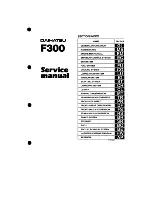
Braking
See Brake System Warning Light on page 3-31.
Braking action involves perception time and reaction
time. First, you have to decide to push on the brake
pedal. That is perception time. Then you have to bring
up your foot and do it. That is reaction time.
Average reaction time is about three-fourths of
a second. But that is only an average. It might be less
with one driver and as long as two or three seconds or
more with another. Age, physical condition, alertness,
coordination, and eyesight all play a part. So do alcohol,
drugs, and frustration. But even in three-fourths of
a second, a vehicle moving at 60 mph (100 km/h) travels
66 feet (20 m). That could be a lot of distance in an
emergency, so keeping enough space between your
vehicle and others is important.
And, of course, actual stopping distances vary greatly
with the surface of the road, whether it is pavement
or gravel; the condition of the road, whether it is wet,
dry, or icy; tire tread; the condition of the brakes; the
weight of the vehicle; and the amount of brake force
applied.
Avoid needless heavy braking. Some people drive in
spurts — heavy acceleration followed by heavy
braking — rather than keeping pace with traffic. This is
a mistake. The brakes might not have time to cool
between hard stops. The brakes will wear out much faster
if you do a lot of heavy braking. If you keep pace with the
traffic and allow realistic following distances, you will
eliminate a lot of unnecessary braking. That means better
braking and longer brake life.
If your vehicle’s engine ever stops while you are driving,
brake normally but do not pump the brakes. If you do,
the pedal could get harder to push down. If the
engine stops, you will still have some power brake
assist. But you will use it when you brake. Once the
power assist is used up, it can take longer to stop and
the brake pedal will be harder to push.
If your vehicle has Electronic Stability Control (ESC)
and the 2.0L turbocharged engine, it also has a
hydraulic brake boost feature which supplements the
power brake system to maintain consistent brake
performance under conditions of low brake booster
vacuum. Low brake booster vacuum conditions
can include initial start up after the vehicle has been
parked for several hours, very frequent brake stops, or
high altitude driving. When hydraulic brake boost is
active, you might feel minor brake pulsation or
movement but this is normal. If brake pedal feel changes
or the brake pedal feels hard to push, you might not
be receiving the intended brake boost and the SVC
BRAKE SYSTEM DIC message may be displayed.
Adding non-dealer/non-retailer accessories can affect
your vehicle’s performance. See Accessories and
Modifications on page 5-3.
4-4
Summary of Contents for 2008 Cobalt
Page 74: ... NOTES 1 70 ...
Page 121: ... NOTES 3 3 ...
Page 122: ...Instrument Panel Overview 3 4 ...
Page 176: ...Radio s Radio with CD Base Radio with CD MP3 shown Radio with Six Disc CD MP3 similar 3 58 ...
Page 196: ... NOTES 3 78 ...
Page 238: ... NOTES 4 42 ...
Page 314: ...A Cover B Retainer C Spare Tire D Wing Nut E Jack and Wheel Wrench F Bolt 5 76 ...
Page 352: ... NOTES 5 114 ...
















































